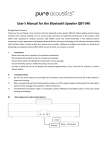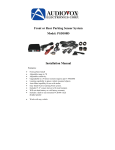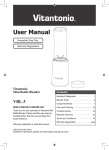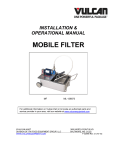Download Leak Detection Troubleshooting - Pioneer Website
Transcript
Toubleshooting -‐ Basic Leak Detection Troubleshooting for leaks with home owner 1. Collect information Ask customer to make some observations regarding water level first. The pad area with the plumbing equipment should be checked first to look for any obvious dripping or leaks around fittings or equipment. A “Bucket Test” can be performed to determine how much of the observed water loss is due to evaporation or from an actual leak. Also, a “Static Test” or “Pump on/Pump off Test” can be done. 2. Bucket Test/Evaporation Test a) Bring pool water level to regular operating level (with garden hose top-‐up if necessary). b) Fill a large bucket with water approximately 3” to 4” from the top – some rocks may be placed in the bucket for stability. c) Place bucket on first or second step. d) Mark water level on the inside of the bucket. e) Shut pool system off and mark pool water level on the outside of the bucket. f) Then, resume normal pump/system operation. g) Wait 24 hours and then observe the water levels again on both the outside and inside of the bucket. h) If the outside mark is down more than the inside watermark, then the water loss is likely not due to evaporation, but likely due to a leak somewhere. A service technician will need to be contacted. ** It is important to note that this test must be done over a 24 hour period without any rain. 3. Static Test a) Further to the evaporation test, the customer may isolate the source of the leak through the static test. b) Ask the customer to turn the filter pump off, and use their winter plugs to plug the skimmer and return lines. c) Ask the customer to mark the current water level (a piece of duct tape is ideal) and monitor with the equipment off for 24 hours. d) If the water level continues to drop significantly in that time, then we can conclude with the customer that the source of the leak is likely inside the pool somewhere either on the liner or at the stair gasket for example. e) An electronic search and locate call should be book with the customer for our Vinyl Master team to go out and find the leak. Inform the customer that this call could turn into a Drain, Search and Repair Call once the source is located. f) Obtain the Credit Card info from the customer and book the Electronic Leak Detect Call. g) If the water level holds (does not drop) in the 24 hour period, then we can conclude with the customer that there is likely a leak on the plumbing side of the pool and a Pressure Check Test should be booked with the customer to find the leak. h) Obtain the Credit Card number from the customer and book the Pressure Test Call. 4. Pump On/Pump Off Test a) Compare results of the bucket test with the pump on for 24 hours and then with the pump off for 24 hours. b) If the water loss (pump on) is greater than water loss (pump off), then there may likely be a leak in the return lines of plumbing system. c) If water loss (pump on) is less than water loss (pump off), then it is likely a skimmer leak, skimmer gasket leak or maindrain plumbing leak – from the suction side/ intake side plumbing. d) If water loss (pump on) equals water loss (pump off), then likely a liner leak (or non-‐plumbing). ** This test must also be conducted in the absence of rain – clear/fair weather. These tests are not 100% accurate, yet they can certainly help a customer to troubleshoot their concerns. This information may also be valuable to the pool technician when contacted to locate a leak.











